中考英语倒装句(最全面-最简洁)
- 格式:ppt
- 大小:808.50 KB
- 文档页数:18
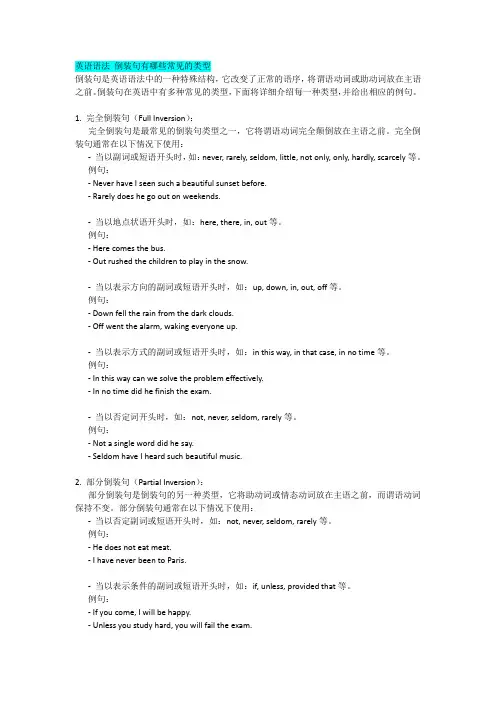
英语语法倒装句有哪些常见的类型倒装句是英语语法中的一种特殊结构,它改变了正常的语序,将谓语动词或助动词放在主语之前。
倒装句在英语中有多种常见的类型,下面将详细介绍每一种类型,并给出相应的例句。
1. 完全倒装句(Full Inversion):完全倒装句是最常见的倒装句类型之一,它将谓语动词完全颠倒放在主语之前。
完全倒装句通常在以下情况下使用:-当以副词或短语开头时,如:never, rarely, seldom, little, not only, only, hardly, scarcely等。
例句:- Never have I seen such a beautiful sunset before.- Rarely does he go out on weekends.-当以地点状语开头时,如:here, there, in, out等。
例句:- Here comes the bus.- Out rushed the children to play in the snow.-当以表示方向的副词或短语开头时,如:up, down, in, out, off等。
例句:- Down fell the rain from the dark clouds.- Off went the alarm, waking everyone up.-当以表示方式的副词或短语开头时,如:in this way, in that case, in no time等。
例句:- In this way can we solve the problem effectively.- In no time did he finish the exam.-当以否定词开头时,如:not, never, seldom, rarely等。
例句:- Not a single word did he say.- Seldom have I heard such beautiful music.2. 部分倒装句(Partial Inversion):部分倒装句是倒装句的另一种类型,它将助动词或情态动词放在主语之前,而谓语动词保持不变。
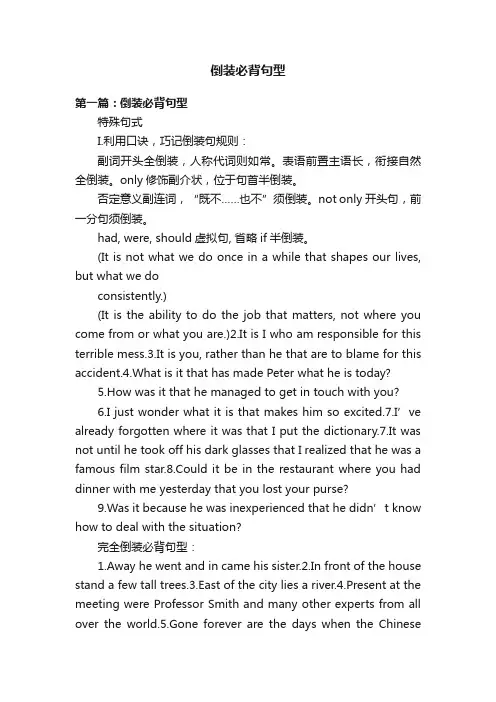
倒装必背句型第一篇:倒装必背句型特殊句式I.利用口诀,巧记倒装句规则:副词开头全倒装,人称代词则如常。
表语前置主语长,衔接自然全倒装。
only修饰副介状,位于句首半倒装。
否定意义副连词,“既不……也不”须倒装。
not only开头句,前一分句须倒装。
had, were, should虚拟句, 省略if半倒装。
(It is not what we do once in a while that shapes our lives, but what we doconsistently.)(It is the ability to do the job that matters, not where you come from or what you are.)2.It is I who am responsible for this terrible mess.3.It is you, rather than he that are to blame for this accident.4.What is it that has made Peter what he is today?5.How was it that he managed to get in touch with you?6.I just wonder what it is that makes him so excited.7.I’ve already forgotten where it was that I put the dictionary.7.It was not until he took off his dark glasses that I realized that he was a famous film star.8.Could it be in the restaurant where you had dinner with me yesterday that you lost your purse?9.Was it because he was inexperienced that he didn’t know how to deal with the situation?完全倒装必背句型:1.Away he went and in came his sister.2.In front of the house stand a few tall trees.3.East of the city lies a river.4.Present at the meeting were Professor Smith and many other experts from all over the world.5.Gone forever are the days when the Chinesepeople were looked down upon.6.Seated / Sitting on the ground is a young man playing the guitar.There be 句型练习1.______ doesn’t seem to have any trouble in sloving this problem.A.ItB.ThereC.ThatD.He2.______ being fine, we went out to enjoy oursleves.部分倒装必背句型:_______ being no bus, the students had to walk home 1.Little does he care about what he wears.A.There;itB.It;ThereC.There;ThereD.It;It 2.By no means is this the first time that you have lied to me.3._______a long way from here to there._____ a long way to go before the sun sets.3.I finally got the job I dreamed about.Never in all my life had I felt so happy.A.It’s;It’sB.There’s;It’sC.It’s;There’sD There’s;There’s(Never shall I forget the days when I lived together with you.)4.There is nothing wrong with your car, ___? 4.Not until I shouted at the top of my voice did he turn around.A.are youB.isn’t itC.aren’t youD.is there5.Not only was the city polluted but(also)the streets were crowded.5.There ought to be an exam this week,___?(New technology was used in teaching.As a result, not only was teachers’ energy saved, but studentsA.oughtn’t itB.isn’t itC.oughtn’t thereD.isn’t there became more interested in the lessons.)6.There is _____what the weather will be like tomorrow.6.Hardly had he arrived at the railway station when he called me up.A.no knowingB.no knownC.not knowingD.not known7.Only if you get a full night’s sleep can you concentrate on your study.7.—Has everyone in your class passed the driving test? = Only after a full nig ht’s sleep can you concentrate on your study.—No,_____only Yang mei and I who _____passed.8.Sofast did he run that I couldn’t catch up with him.A.it was;hadB.there were;hadC.there is;haveD.it is;have 9.Such a loud noise did he make that I couldn’t make my self heard.8.______ is no need to attend the lecture, for it isn’t important.10.1)Hero as he is, he remains modest.A.ItB.ThereC.ThisD.He2)(As)Talented as he is, he is not hard-working.9.The secretary arranged for _____ another interview.3)Much as I respect you, I don’t agree with you.A.it to beB.there beingC.there to beD.there to have4)Try as he might, he couldn’t push the door open.10.I want there _______ no mistake about it.11.1)Were I you, I would accept his advice.A.will beB.isC.to beD.being2)You wouldn’t have failed had you asked me for help.11.There___no rain for a long time, the ground was burnt black by the sun.3)Should you be fired, your health care and other benefits will not be immediately cut off.A.wasB.had beenC.has beenD.having been(Should you be interested, I have a book on the subject you might like to see.)12.I thought there _______ a football match show on TV, but there wasn’t.12.May you be lucky!/ May our friendship last forever!A.was going to beB.was going to haveC.would haveD.was II.强调句必背句型:1.It is not how much you read but what you read that counts/matters/is of great importance.(It is not how much we do but how much love we put into what we do that benefits our workmost.)第二篇:作文必背句型作文必背句型1.Recently, there is a heated debate on… 最近,就…展开了热烈的讨论。
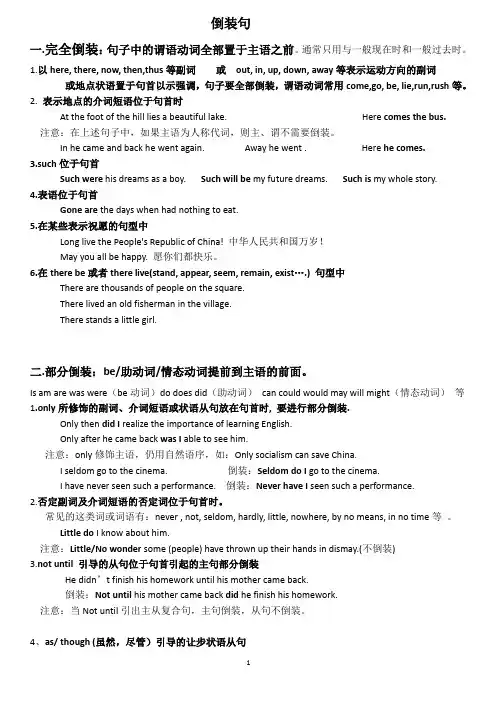
倒装句一.完全倒装:句子中的谓语动词全部置于主语之前。
通常只用与一般现在时和一般过去时。
1.以here, there, now, then,thus等副词或out, in, up, down, away等表示运动方向的副词或地点状语置于句首以示强调,句子要全部倒装,谓语动词常用come,go, be, lie,run,rush等。
2.表示地点的介词短语位于句首时At the foot of the hill lies a beautiful lake. Here comes the bus.注意:在上述句子中,如果主语为人称代词,则主、谓不需要倒装。
In he came and back he went again. Away he went . Here he comes.3.such位于句首Such were his dreams as a boy. Such will be my future dreams. Such is my whole story.4.表语位于句首Gone are the days when had nothing to eat.5.在某些表示祝愿的句型中Long live the People's Republic of China! 中华人民共和国万岁!May you all be happy. 愿你们都快乐。
6.在there be或者there live(stand, appear, seem, remain, exist….) 句型中There are thousands of people on the square.There lived an old fisherman in the village.There stands a little girl.二.部分倒装:be/助动词/情态动词提前到主语的前面。
Is am are was were(be动词)do does did(助动词)can could would may will might(情态动词)等1.only所修饰的副词、介词短语或状语从句放在句首时, 要进行部分倒装.Only then did I realize the importance of learning English.Only after he came back was I able to see him.注意:only修饰主语,仍用自然语序,如:Only socialism can save China.I seldom go to the cinema. 倒装:Seldom do I go to the cinema.I have never seen such a performance. 倒装:Never have I seen such a performance.2.否定副词及介词短语的否定词位于句首时。
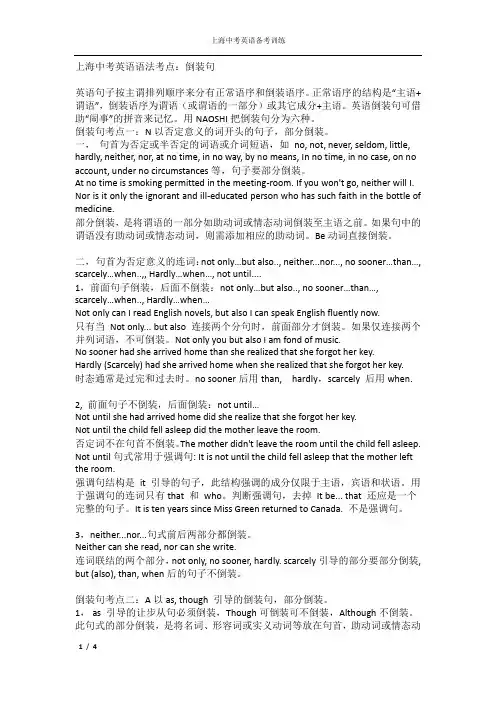
上海中考英语语法考点:倒装句英语句子按主谓排列顺序来分有正常语序和倒装语序。
正常语序的结构是“主语+谓语”,倒装语序为谓语(或谓语的一部分)或其它成分+主语。
英语倒装句可借助“闹事”的拼音来记忆。
用NAOSHI把倒装句分为六种。
倒装句考点一:N以否定意义的词开头的句子,部分倒装。
一,句首为否定或半否定的词语或介词短语,如no, not, never, seldom, little, hardly, neither, nor, at no time, in no way, by no means, In no time, in no case, on no account, under no circumstances等,句子要部分倒装。
At no time is smoking permitted in the meeting-room. If you won't go, neither will I. Nor is it only the ignorant and ill-educated person who has such faith in the bottle of medicine.部分倒装,是将谓语的一部分如助动词或情态动词倒装至主语之前。
如果句中的谓语没有助动词或情态动词,则需添加相应的助动词。
Be动词直接倒装。
二,句首为否定意义的连词:not only…but also.., neither...nor..., no sooner…than…, scarcely…when..,, Hardly…when…, not until....1,前面句子倒装,后面不倒装:not only…but also.., no sooner…than…, scarcely…when.., Hardly…when…Not only can I read English novels, but also I can speak English fluently now.只有当Not only... but also 连接两个分句时,前面部分才倒装。
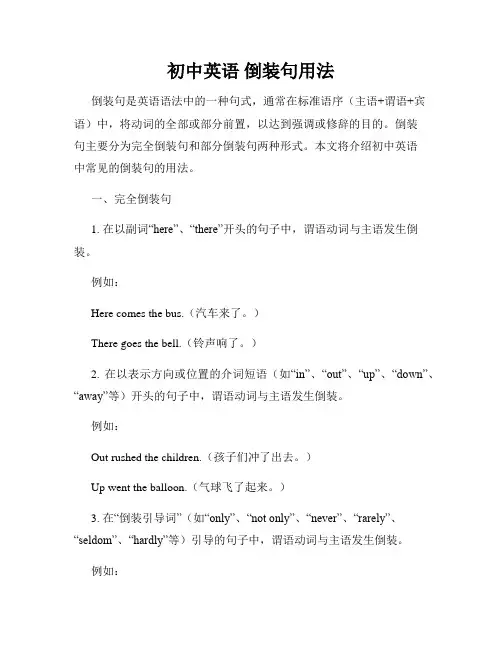
初中英语倒装句用法倒装句是英语语法中的一种句式,通常在标准语序(主语+谓语+宾语)中,将动词的全部或部分前置,以达到强调或修辞的目的。
倒装句主要分为完全倒装句和部分倒装句两种形式。
本文将介绍初中英语中常见的倒装句的用法。
一、完全倒装句1. 在以副词“here”、“there”开头的句子中,谓语动词与主语发生倒装。
例如:Here comes the bus.(汽车来了。
)There goes the bell.(铃声响了。
)2. 在以表示方向或位置的介词短语(如“in”、“out”、“up”、“down”、“away”等)开头的句子中,谓语动词与主语发生倒装。
例如:Out rushed the children.(孩子们冲了出去。
)Up went the balloon.(气球飞了起来。
)3. 在“倒装引导词”(如“only”、“not only”、“never”、“rarely”、“seldom”、“hardly”等)引导的句子中,谓语动词与主语发生倒装。
例如:Only when it snows do we go skiing.(只有下雪的时候我们才去滑雪。
)Not until yesterday did I realize my mistake.(直到昨天我才意识到我的错误。
)4. 在以表示条件的介词短语(如“in case”、“if”、“should”等)引导的句子中,谓语动词与主语发生倒装。
例如:In case of fire, leave the building immediately.(万一发生火灾,立即离开建筑物。
)Should you have any questions, please feel free to ask.(如果你有任何问题,请随时提问。
)二、部分倒装句1. 在以否定词开头的句子中(如“never”、“seldom”、“hardly”、“scarcely”等),谓语动词的助动词与主语发生倒装。
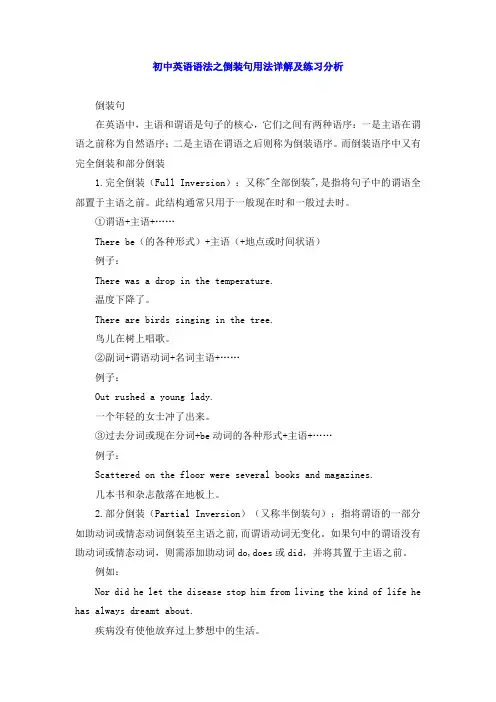
初中英语语法之倒装句用法详解及练习分析倒装句在英语中,主语和谓语是句子的核心,它们之间有两种语序:一是主语在谓语之前称为自然语序;二是主语在谓语之后则称为倒装语序。
而倒装语序中又有完全倒装和部分倒装1.完全倒装(Full Inversion):又称"全部倒装",是指将句子中的谓语全部置于主语之前。
此结构通常只用于一般现在时和一般过去时。
①谓语+主语+……There be(的各种形式)+主语(+地点或时间状语)例子:There was a drop in the temperature.温度下降了。
There are birds singing in the tree.鸟儿在树上唱歌。
②副词+谓语动词+名词主语+……例子:Out rushed a young lady.一个年轻的女士冲了出来。
③过去分词或现在分词+be动词的各种形式+主语+……例子:Scattered on the floor were several books and magazines.几本书和杂志散落在地板上。
2.部分倒装(Partial Inversion)(又称半倒装句):指将谓语的一部分如助动词或情态动词倒装至主语之前,而谓语动词无变化。
如果句中的谓语没有助动词或情态动词,则需添加助动词do,does或did,并将其置于主语之前。
例如:Nor did he let the disease stop him from living the kind of life he has always dreamt about.疾病没有使他放弃过上梦想中的生活。
部分倒装也有以下几种常见类型:1. 以否定词开头的句子要求部分倒装。
注意下列句子中助动词或情态动词提前、甚至补充助动词的用法:例:Not until yesterday did little John change his mind.小约翰直到昨天才改变了主意。
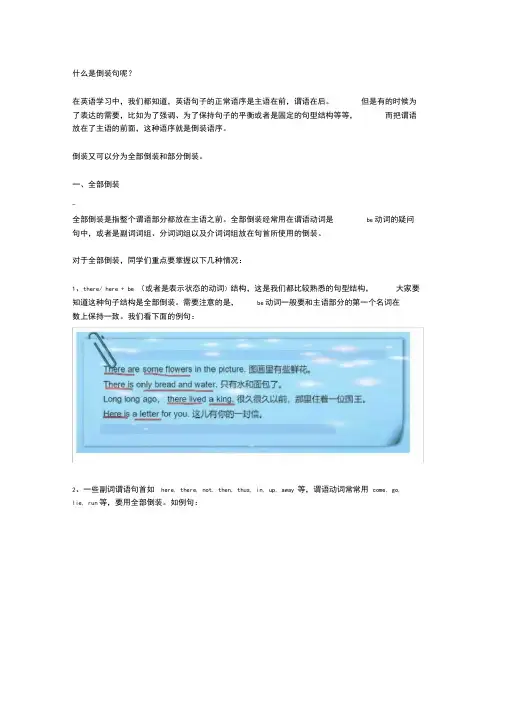
什么是倒装句呢?在英语学习中,我们都知道,英语句子的正常语序是主语在前,谓语在后。
但是有的时候为了表达的需要,比如为了强调、为了保持句子的平衡或者是固定的句型结构等等,而把谓语放在了主语的前面,这种语序就是倒装语序。
倒装又可以分为全部倒装和部分倒装。
一、全部倒装-全部倒装是指整个谓语部分都放在主语之前。
全部倒装经常用在谓语动词是be动词的疑问句中,或者是副词词组、分词词组以及介词词组放在句首所使用的倒装。
对于全部倒装,同学们重点要掌握以下几种情况:1、there/ here + be (或者是表示状态的动词)结构,这是我们都比较熟悉的句型结构,大家要知道这种句子结构是全部倒装。
需要注意的是,be动词一般要和主语部分的第一个名词在数上保持一致。
我们看下面的例句:2、一些副词谓语句首如here, there, not, then, thus, in, up, away 等,谓语动词常常用come, go, lie, run等,要用全部倒装。
如例句:3、如果句子中的地点状语提前,谓语动词是be, sit, come, lie, stand等的时候,需要全部倒装。
例如:On the hill stands a temple.山上立着一座庙宇。
4、直接引语的一部分或者全部放在句首的时候,要全部倒装,如例句1;但是如果主语为代词或谓语还有其他词修饰的时候,则不能倒装,如例句2;介词短语作表语的时候为了表示强调,可以使用倒装,如例句3:---------------------------- :—made gical progress last term, sjiid histeacher-J- - -- - —:蚣--i 他的老师说“上学期肖明取祖了很大进步J.2、“ What are you doing?" he asked.. 它问“你在做什么?,:3、At the head of tlic queue was an old woman, 排头的是位老太太,.二、接下来我们说说部分倒装。
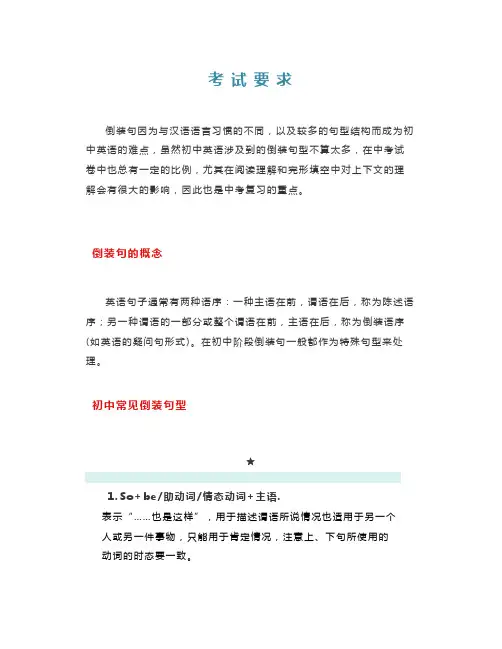
考试要求倒装句因为与汉语语言习惯的不同,以及较多的句型结构而成为初中英语的难点,虽然初中英语涉及到的倒装句型不算太多,在中考试卷中也总有一定的比例,尤其在阅读理解和完形填空中对上下文的理解会有很大的影响,因此也是中考复习的重点。
倒装句的概念英语句子通常有两种语序:一种主语在前,谓语在后,称为陈述语序;另一种谓语的一部分或整个谓语在前,主语在后,称为倒装语序(如英语的疑问句形式)。
在初中阶段倒装句一般都作为特殊句型来处理。
初中常见倒装句型★1.So+b e/助动词/情态动词+主语.表示“……也是这样”,用于描述谓语所说情况也适用于另一个人或另一件事物,只能用于肯定情况,注意上、下句所使用的动词的时态要一致。
例如Y o u c a n r i de a bi k e.S o c a n I.你会骑自行车,我也会。
H e h a s b e en t o B e i j i n g.S o h a v e I.他去过北京,我也去过。
L i n P i n g w a s t h e r e l a st n i gh t.S o w a s e v er y o n ee l s e i n m y c l a s s.林平昨晚在那里,我们班其他人昨晚也都在那里。
H e s a w t h e s n a k e,a n d so di d I.他看见那条蛇了,我也看到了。
★注意:如果前一个句子有b e、助动词(如h a v e,w i l l等)和情态动词(如c a n,m u st等),就把这些词放在另一个句子主语前。
如果前一个句子谓语动词是行为动词,后句中要把助动词d o,d o e s或di d放在主语前,就像行为动词变疑问句一样。
★辨析:“S o+主语+b e/助动词/情态动词.”此句型不是倒装句,只是单纯地重复前面一句的意思,表示“的确如此;就是这样”。
例如—M y l i t t l e br o t h e r c a n sw i m i n t h e s e a.——我的小弟弟能在大海里游泳。
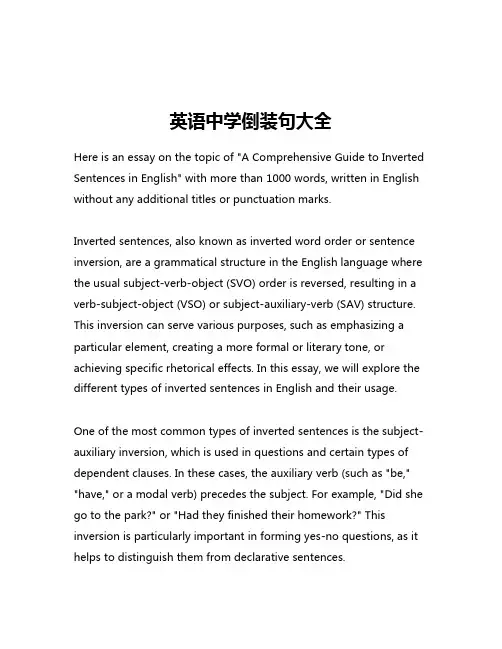
英语中学倒装句大全Here is an essay on the topic of "A Comprehensive Guide to Inverted Sentences in English" with more than 1000 words, written in English without any additional titles or punctuation marks.Inverted sentences, also known as inverted word order or sentence inversion, are a grammatical structure in the English language where the usual subject-verb-object (SVO) order is reversed, resulting in a verb-subject-object (VSO) or subject-auxiliary-verb (SAV) structure. This inversion can serve various purposes, such as emphasizing a particular element, creating a more formal or literary tone, or achieving specific rhetorical effects. In this essay, we will explore the different types of inverted sentences in English and their usage.One of the most common types of inverted sentences is the subject-auxiliary inversion, which is used in questions and certain types of dependent clauses. In these cases, the auxiliary verb (such as "be," "have," or a modal verb) precedes the subject. For example, "Did she go to the park?" or "Had they finished their homework?" This inversion is particularly important in forming yes-no questions, as it helps to distinguish them from declarative sentences.Another type of inverted sentence is the verb-subject-object (VSO) construction, which is less common in English but can be found in certain contexts. This inversion is often used in formal or literary writing, as well as in certain fixed expressions or idioms. For instance, "Went the boy to the store," or "Comes the dawn, we shall depart."Inverted sentences can also be used for emphasis or to create a sense of drama or suspense. This is known as "stylistic inversion" and is often found in poetic or rhetorical language. Examples of this type of inversion include "Never have I seen such a sight," or "Only then did she realize the truth."Inversion can also occur in conditional sentences, where the subject and auxiliary verb are inverted in the "if" clause. For example, "Had I known, I would have helped you," or "Should you need assistance, please let me know."In addition to these more common types of inversion, there are also more complex and specialized forms of inverted sentences in English. For instance, "Rarely do we see such a phenomenon," which inverts the subject and auxiliary verb to create emphasis on the adverb "rarely."Inverted sentences can also be used in constructions with "there" as the subject, such as "There is the problem we need to address," or"Here comes the bus." In these cases, the subject is placed after the verb to create a more formal or impersonal tone.Another type of inversion is the "negative inversion," which occurs when a negative adverb or phrase is placed at the beginning of the sentence, causing the subject and auxiliary verb to be inverted. Examples include "Never have I been so proud," or "Hardly had they arrived when the storm began."Inverted sentences can also be found in certain types of dependent clauses, such as those introduced by words like "only," "hardly," "scarcely," or "barely." In these cases, the subject and auxiliary verb are inverted, as in "Only when the sun sets do we see the true beauty of the landscape."It's important to note that while inverted sentences can add variety, emphasis, and a more formal or literary tone to one's writing, they should be used judiciously and in appropriate contexts. Overuse of inversion can make the writing seem stilted or affected, so it's essential to strike a balance and use these structures purposefully and effectively.In conclusion, inverted sentences are a versatile and powerful tool in the English language, allowing writers and speakers to create a range of rhetorical effects and to express their ideas in a more nuanced andcompelling manner. By understanding the different types of inversion and their appropriate usage, one can enhance their command of the English language and become a more skilled and expressive communicator.。
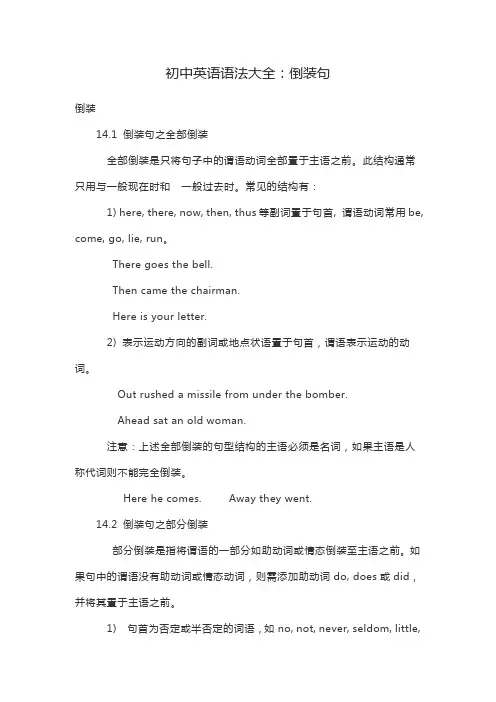
初中英语语法大全:倒装句倒装14.1 倒装句之全部倒装全部倒装是只将句子中的谓语动词全部置于主语之前。
此结构通常只用与一般现在时和一般过去时。
常见的结构有:1) here, there, now, then, thus等副词置于句首, 谓语动词常用be, come, go, lie, run。
There goes the bell.Then came the chairman.Here is your letter.2) 表示运动方向的副词或地点状语置于句首,谓语表示运动的动词。
Out rushed a missile from under the bomber.Ahead sat an old woman.注意:上述全部倒装的句型结构的主语必须是名词,如果主语是人称代词则不能完全倒装。
Here he comes. Away they went.14.2 倒装句之部分倒装部分倒装是指将谓语的一部分如助动词或情态倒装至主语之前。
如果句中的谓语没有助动词或情态动词,则需添加助动词do, does或did,并将其置于主语之前。
1) 句首为否定或半否定的词语,如no, not, never, seldom, little,hardly, at no time, in no way, not until…等。
Never have I seen such a performance.Nowhere will you find the answer to this question.Not until the child fell asleep did the mother leave the room.当Not until引出主从复合句,主句倒装,从句不倒装。
注意:如否定词不在句首不倒装。
I have never seen such a performance.The mother didn't leave the room until the child fell asleep.典型例题1) Why can't I smoke here?At no time___ in the meeting-roomA. is smoking permittedB. smoking is permittedC. smoking is it permittedD. does smoking permit答案A. 这是一个倒装问题。
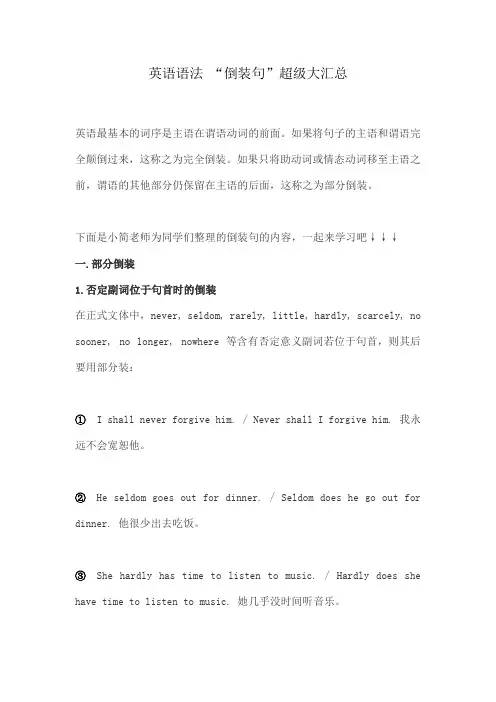
英语语法“倒装句”超级大汇总英语最基本的词序是主语在谓语动词的前面。
如果将句子的主语和谓语完全颠倒过来,这称之为完全倒装。
如果只将助动词或情态动词移至主语之前,谓语的其他部分仍保留在主语的后面,这称之为部分倒装。
下面是小简老师为同学们整理的倒装句的内容,一起来学习吧↓↓↓一.部分倒装1.否定副词位于句首时的倒装在正式文体中,never, seldom, rarely, little, hardly, scarcely, no sooner, no longer, nowhere 等含有否定意义副词若位于句首,则其后要用部分装:①I shall never forgive him. / Never shall I forgive him. 我永远不会宽恕他。
②He seldom goes out for dinner. / Seldom does he go out for dinner. 他很少出去吃饭。
③She hardly has time to listen to music. / Hardly does she have time to listen to music. 她几乎没时间听音乐。
④He little realizes how important this meeting is. / Little does he realize how important this meeting is. 他不甚明白这个会议的重要性。
⑤We had no sooner reached the airport than the plane took off. / No sooner had we reached the airport than the plane took off. 我们刚到机场,飞机就起飞了。
注意(1) 对于not…until句型,当not until…位于句首时,其后的主句要用倒装语序:He didn’t leave the room until the rain stopped. / Not until the rain stopped did he leave the room. 雨停了之后他才离开这房间。
初中英语语法讲解:倒装句定义为了强调、突出等语用目的而颠倒原有语序的句式叫做倒装句.在倒装句中,颠倒了的成分可以恢复原位而句意基本不变,句法成分不变.英语倒装句(Inversion)主语和谓语是句子的核心,它们之间有两种语序:一是主语在谓语之前称为自然语序(Natural Order);二是主语在谓语之后则称为倒装语序(Inverted Order).而倒装语序中又有完全倒装(Full Inversion)和部分倒装(Partial Inversion)完全倒装(Full Inversion):又称“全部倒装”,是只将句子中的谓语动词全部置于主语之前.此结构通常只用与一般现在时和一般过去时.部分倒装(Partial Inversion):指将谓语的一部分如助动词或情态倒装至主语之前.如果句中的谓语没有助动词或情态动词,则需添加助动词do,does或did,并将其置于主语之前。
英语句子的倒装一是由于语法结构的需要而进行的倒装,二是由于修辞的需要而进行的倒装。
前一种情况,倒装是必须的,否则就会出现语法错误;后一种情况,倒装是选择性的,倒装与否只会产生表达效果上的差异.一、表示强调:倒装句最突出、最常见的修辞效果就是强调,其表现形式如下:1、only +状语或状语从句置于句首,句子用部分倒装。
例子:Only in this way can you solve this problem。
只有用这种方法,你才可以解决这个问题。
Only after he had spoken out the word did he realize he had made a big mistake。
只有当他已经说出那个字后才意识到自己犯了个大错误.2、hardly、in no way、little、scarcely、seldom、never、no more、no longer、not、not only、no sooner、not only … (but also)、not until… 等具有否定意义的词或词组位于句首,句子用部分倒装.例子:No sooner had I got home than it began to rain.我刚到家就下起了雨。
英语中的倒装句结构有哪些?在英语中,倒装句指的是将谓语动词或助动词置于主语之前的句子结构。
倒装句可以用于不同的语法结构和句型中。
下面是英语中常见的几种倒装句结构:1. 完全倒装句(Full Inversion):-以副词或介词短语开头的句子:Adverbial inversion- Never have I seen such a beautiful sunset.(我从未见过如此美丽的日落。
)- In the garden sat a little girl.(花园里坐着一个小女孩。
)-以表示否定的副词或短语开头的句子:Negative inversion- Not only did she pass the exam, but she also got the highest score.(她不仅通过了考试,而且还得到了最高分。
)- Under no circumstances should you give up.(无论如何,你都不应该放弃。
)-以表示条件的副词或短语开头的句子:Conditional inversion- Should you need any assistance, please let us know.(如果你需要任何帮助,请告诉我们。
)- Were he to win the lottery, he would buy a new car.(如果他中了彩票,他会买一辆新车。
)2. 部分倒装句(Partial Inversion):-以否定副词开头的句子:Negative adverbial inversion- Never have I been so insulted in my life.(我一生中从未受过如此侮辱。
)- Rarely do I go to bed before midnight.(我很少在午夜前上床睡觉。
)-以表示方向或地点的副词短语开头的句子:Adverbial phrase inversion- Up the hill ran the children.(孩子们跑上山。
初中英语语法-倒装句英语句子的自然语序是主语在前,谓语在后。
把谓语放在主语之前,就叫做倒装。
全部谓语放在主语之前,叫做全部倒装;只把部分谓语即be动词、助动词或情态动词放在主语之前,叫做部分倒装。
1. 存在句(there be/ live/ stand/ lie/ seem等)需要全部倒装。
如:There once lived an old hunter in the house.这所房子里曾住过一位老猎人。
There seems to be many listeners. 似乎有很多听众。
2. 副词here, there, now, then等置于句首(经常与go, come等动词连用),全句需要全部倒装。
如:Here comes the bus. 公共汽车来了。
Now comes your turn. 现在轮到你了。
注意:如果主语是人称代词则不用倒装。
如:Here they are. 他们在这儿。
3. 介词短语作为地点状语置于句首,后面如果有lie, live, sit, stand, come, go等动词,全句需要全部倒装。
如:Into the hall came three women. 大厅里走进来三位妇女。
In the east of the school lies a big bookshop.学校的东边有一个大的书店。
4. 当上文所表达的含义也适用于另一个人或物时,要用so/ neither/ nor+be/ 助词/ 情态动词+主语;此时谓语的时态、语态应与前句谓语的时态、语态相一致。
如: —I have finished my homework.我已经做完作业了。
—So has he. 他也做完了。
—I haven’t seen that film. 我没看过那部电影。
—Neither (Nor) have I. 我也没有。
5. not only... but also...连接两个并列句,且not only置于句首时,前句需要部分倒装。